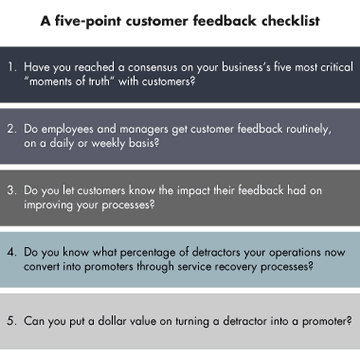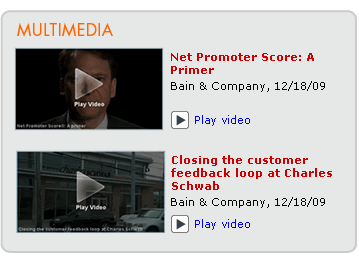Article
Most companies devote a lot of energy to listening to the "voice of the customer." But the best listen right at the front line. They don't filter the feedback through centralized market research mechanisms. Employees receive evaluations from the people best able to render an appraisal—the customers they serve every day. The employees follow up with willing customers in one-on-one conversations. Through active listening, they strive to understand in detail what customers value and what they can do to deliver it better. Over time, companies use this data to make process and policy refinements that add up to a better experience for all customers.
The strongest feedback loops aim to keep the customer front and center across the entire organization. Conventional research approaches like mystery shoppers, satisfaction market research and periodic forums between employees and customers can help. But one of the most effective ways to create closed-loop customer feedback is based on the Net Promoter® Score (NPS®).
NPS categorizes customers into three groups—promoters, passives and detractors. It allows employees to see instantly whether a customer experience was a success or a failure—and why. The Net Promoter Score itself is generated by asking a single question, "How likely would you be to recommend [this company or product] to a friend or a colleague?" Respondents giving marks of 9 or 10 are promoters, a company's most devoted customers. Those scoring 7 or 8 are passives, and those rating their experience from 0 to 6 are detractors. NPS is the percentage of promoters minus the percentage of detractors. Importantly, customers are then asked why they would be likely or unlikely to recommend the company. The feedback gathered enables employees to learn quickly how to create fewer detractors and more promoters.

Gathering Feedback on the Front Line
Say that thousands of transactions occur daily between customers and front-line employees at your company. Each is an opportunity to create a promoter. But the customer experiences that matter most are "moments of truth," those few contacts that hold the greatest potential to delight—or alienate—customers.
Allianz CEO Michael Diekmann understood that in 2004 when he set out to bring his global financial services enterprise closer to its customers. Diekmann and his leadership team recognized that no group was better positioned to pinpoint the make-or-break customer experiences than Allianz's thousands of customer-facing employees. The company assembled a small customer-focus team, reporting to the board, to design and test a feedback system and then roll it out in most of the 70 countries where Allianz operated. The team chose NPS as its core metric.
Here's how Allianz's system works: After every important transaction, a research firm immediately contacts the customer and conducts a brief survey. It quickly e-mails results to the employee who provided the service and publishes aggregated results on intranet "dashboards." Employees then follow up to learn more by calling all detractors who've agreed to be contacted, and a sample of promoters. After listening, they correct the problems or find someone who can. Because front-line employees take responsibility for lifting their unit's scores, they meet frequently to devise service improvements.
 At companies with strong feedback systems, business-unit leaders and front-line employees start to "own" customer loyalty the same way they own targets for revenue, profits and market share.
At companies with strong feedback systems, business-unit leaders and front-line employees start to "own" customer loyalty the same way they own targets for revenue, profits and market share.
Organizations that use NPS to create closed-loop customer feedback learn faster how to create more promoters. That keeps customers coming back and recommending their company, and keeps the business growing.
Go to the full article, which was published in Harvard Business Review.
Rob Markey is a partner in the New York office of Bain & Company and leads the firm's Global Customer Strategy and Marketing practice. Fred Reichheld is a Bain Fellow and a leading authority on customer loyalty. He is the author of The Ultimate Question: Driving Good Profits and True Growth (Harvard Business Press, 2006). Andreas Dullweber is a partner in Bain's Munich office and leads the firm's European Customer Strategy and Marketing practice.
Additional articles appearing in this edition of the Results Brief newsletter:
Global Private Equity Report 2010
by Hugh MacArthur, Graham Elton, Bill Halloran and Suvir Varma
Challenges still lie ahead, especially in light of the looming refinancing cliff. Building a successful investment business will require PE firms to raise their game in five areas: investment strategy, fund-raising, center and enablers, organization and decisions, and investment capabilities.
Registration required to download full report
The Green Edge: Why Carbon Competitiveness Matters
by Jorge Leis
Most CEOs get the big picture on carbon competitiveness. But few ask how they can use carbon competitiveness to gain an edge over their competitors. The right answer can ensure the longevity of a company in an increasingly regulated world.
Managing IT to Win in the Recovery
by Rudy Puryear
As the economy starts to recover, CEOs need to challenge their CIOs to think creatively in five key areas: finding and fixing IT systems damaged by spending freezes during the downturn; boosting returns from discretionary investments; cutting complexity; developing "good enough" solutions; and making outsourcing more strategic.
® Net Promoter, NPS, and Net Promoter Score are trademarks of Bain & Company, Inc., Satmetrix Systems, Inc. and Fred Reichheld.